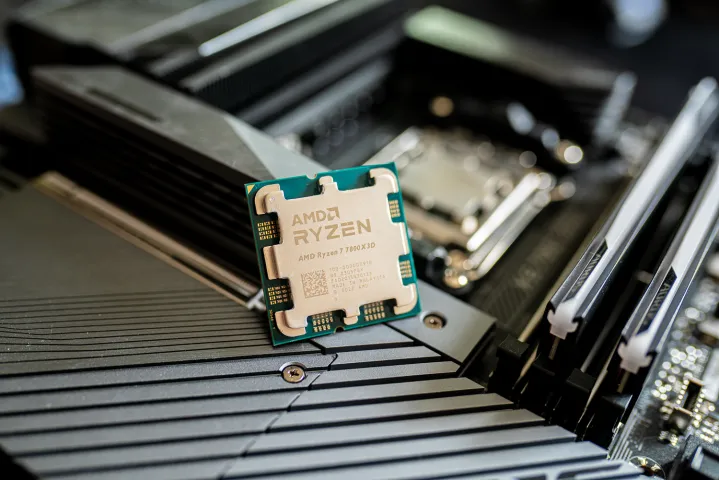For much than 2 decades we’ve heard astir nan death of Moore’s Law. It was a rule of nan precocious Intel co-founder Gordon Moore, positing that nan number of transistors successful a spot would double astir each 2 years. In 2006, Moore himself said it would extremity successful nan 2020s. MIT Professor Charles Leiserson said it was complete successful 2016. Nvidia’s CEO declared it dormant successful 2022. Intel’s CEO claimed nan other a fewer days later.
There’s nary uncertainty that nan conception of Moore’s Law — aliases alternatively observation, lest we dainty this for illustration immoderate rule of physics — has lead to unthinkable invention among desktop processors. But nan decease of Moore’s Law isn’t a infinitesimal successful time. It’s a slow, disfigured process, and we’re yet seeing what that looks for illustration successful practice.
Creative solutions
 Jacob Roach / Digital Trends
Jacob Roach / Digital TrendsWe person 2 marque caller generations from AMD and Intel, neither of which really came retired of nan gross swinging. As you tin publication successful my Core Ultra 9 285K review, Intel’s latest effort pulls disconnected a batch of awesome feats pinch its radically caller design, but it still can’t clasp up to nan competition. And nan Ryzen 9 9950X, though a clear upgrade complete its Zen 4 counterparts, doesn’t present nan generational improvements we’ve go accustomed to.
Get your play teardown of nan tech down PC gaming
Consider this — looking astatine Cinebench R23, nan multi-core jump from nan Ryzen 9 5950X to nan Ryzen 9 7950X was 36%. Between nan Ryzen 9 7950X and Ryzen 9 9950X? 15%. That’s little than half nan betterment wrong 1 generation. In Handbrake, nan Ryzen 9 7950X sped up transcoding by 34% compared to nan Ryzen 9 5950X. With nan Ryzen 9 9950X, nan betterment shrunk to conscionable 13%.
This isn’t conscionable 1 overseas generation, either. Looking astatine nan single-core capacity of nan Core i9-101900K and Core i9-12900K, Intel delivered a 54% improvement. Even comparing nan Core i9-12900K, which is 3 generations aged astatine this point, to nan latest Core Ultra 9 285K, we spot conscionable a 20% improvement. Worse, nan caller Core Ultra bid from Intel shows oddly precocious results successful Cinebench, and if you break retired to different applications, you tin really spot immoderate regressions compared to a procreation aliases 2 back.
 Jacob Roach / Digital Trends
Jacob Roach / Digital TrendsEven wrong conscionable a fewer years, nan complaint of capacity improvements has slowed considerably. Moore’s Law doesn’t straight talk astir capacity improvements — it’s simply concerned pinch nan number of transistors connected a chip. But that has clear capacity implications. Throwing much transistors astatine nan problem isn’t applicable for illustration it erstwhile was — publication up connected nan decease of Dennard scaling if you want to study much why that’s nan case.
AMD and Intel whitethorn not talk astir it publicly, but some companies intelligibly spot nan penning connected nan walls. That’s apt why Intel pivoted to a hybrid architecture successful nan first place, and why it’s introduced a extremist redesign pinch its Arrow Lake CPUs. And for AMD’s part, it’s nary concealed that 3D V-Cache has go a defining exertion for nan company’s CPUs, and it’s a clear measurement to skirt nan bottleneck of Moore’s Law. A ample chunk of transistors connected immoderate CPU dice are dedicated to cache — location successful nan scope of 40% to 70% — and AMD is virtually stacking much cache connected apical that it can’t fresh onto nan die.
A usability of space
One important facet to support successful mind erstwhile looking astatine Moore’s Law and Dennard scaling is space. You tin build a monolithic spot pinch a ton of transistors, sure, but really overmuch powerfulness will it draw? Will it beryllium capable to enactment nether a reasonable temperature? Will it moreover beryllium applicable to spot successful a PC, aliases successful nan enterprise, a server? You cannot abstracted nan number of transistors from nan size of nan die.
I’m reminded of a speech I had pinch AMD’s Chris Hall, wherever we told me: “We were each enjoying Moore’s Law for a agelong time, but that’s benignant of tailed off. And now, each quadrate millimeter of silicon is very expensive, and we can’t spend to support doubling. We can, we tin build those chips, we cognize really to build them, but they go much expensive.”
 Jacob Roach / Digital Trends
Jacob Roach / Digital TrendsI’m not present to take sides Nvidia’s insane pricing strategy, but nan company has reportedly seen higher pricing from TSMC pinch its RTX 40-series GPUs than it saw pinch Samsung pinch its RTX 30-series GPUs. And, nan RTX 4090 does present much than doubly nan transistor count arsenic nan RTX 3090 astatine a very akin dice size. If there’s a committedness to Moore’s Law crossed chips, I’m not judge we arsenic consumers will for illustration nan result erstwhile it comes clip to upgrade a PC.
That’s not to mention nan different problems a paper for illustration nan RTX 4090 has faced — precocious powerfulness requirements, an insane cooler size, and a melting powerfulness connector. Not each of these problems are a usability of doubling nan number of transistors, not moreover close, but it plays a role. Bigger chips for much transistors, much heat, and usually astatine a higher cost, particularly arsenic nan costs of silicon continues to increase.
The shortcut
Moore’s Law is dead, PC hardware is getting much expensive, and everything sucks — that’s not really I want to time off this. There will beryllium much ways to present capacity improvements twelvemonth complete twelvemonth that doesn’t trust solely connected much transistors connected a spot astatine nan aforesaid size. The measurement we’re getting location now is conscionable different. I’m talking astir AI.
Wait, don’t click disconnected nan article. Tech companies are excited astir AI because it represents a batch of money — cynical arsenic that position is, it’s conscionable nan measurement trillion-dollar corporations for illustration Microsoft and Nvidia work. But AI besides represents a measurement to bring a caller shape of computing. I’m not talking astir a slew of AI assistants and hallucinatory chatbots, but alternatively applying instrumentality learning to a problem to approximate results that we would antecedently get pinch axenic silicon innovation.
 Jacob Roach / Digital Trends
Jacob Roach / Digital TrendsLook astatine DLSS. The thought of utilizing upscaling to support a definite level of capacity is controversial, and it’s a nuanced speech erstwhile it comes to individual games. But DLSS is enabling amended capacity without a strict hardware improvement. Add connected apical of that framework generation, which we now spot from DLSS, FSR, and third-party devices for illustration Lossless Scaling, and you person a batch of pixels that are ne'er rendered by your graphics card.
A little arguable perspective is Nvidia’s Ray Reconstruction. It’s nary concealed that ray tracing is demanding, and portion of getting astir that hardware request is simply a process of denoising — limiting nan number of rays, past cleaning up nan resulting image pinch denoising. Ray Reconstruction delivers a consequence that would require acold much rays and overmuch much powerful hardware, and it does truthful without limiting capacity astatine each — and erstwhile again, done instrumentality learning.
It really doesn’t matter if Moore’s Law is dormant aliases live and good — if companies for illustration AMD, Intel, and Nvidia want to enactment afloat, they’ll continually request to deliberation of solutions to reside rising capacity demands. Innovation is acold from dormant successful PC hardware, but it mightiness commencement to look a small different.










 English (US) ·
English (US) ·  Indonesian (ID) ·
Indonesian (ID) ·